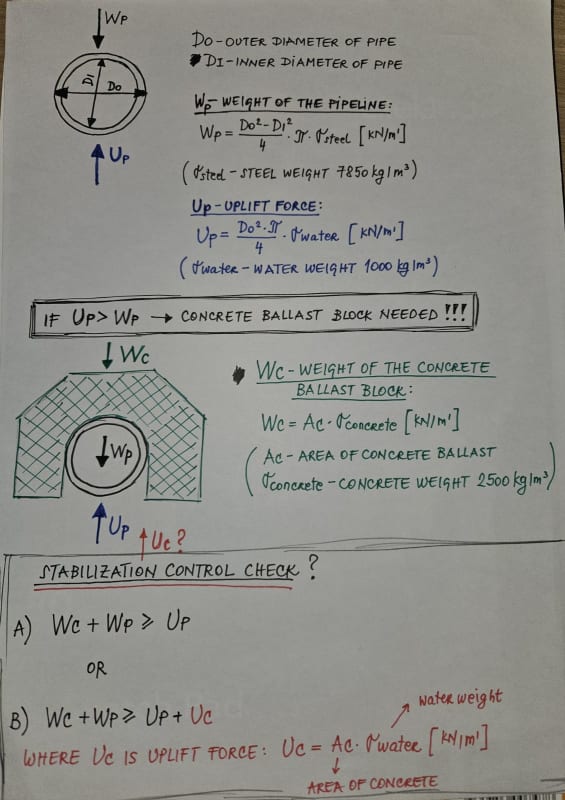Djidji444
Structural
- Mar 11, 2024
- 17
Hello,
I have a question for the calculation of buoyancy/uplift on the pipe in the ground during the construction phase of the pipeline (a trench is dug and the pipeline is placed on the ground only). According to the geotechnical studies, the assumption that the underground water level is at the ground level was adopted. My question boils down to whether, after concrete ballasts are adopted to stabilize the pipe, whether there are, in addition to the uplift force acting on the pipe, additional uplift forces acting on that ballast? In translation, in the next picture I drew, is the stability control done according to formula A or B. I come across old projects where it was calculated according to formula A, and it makes more sense to me that it is calculated according to formula B?

I don't know if it is possible to only take the weight of the concrete block into account without taking into account the additional buoyancy/uplift, only if this is some kind of specific situation, perhaps because this is the construction phase of the pipeline so maybe it is a short period when the buoyancy forces affecting the concrete part are not form, I don't know...
Thanks in advance![[upsidedown] [upsidedown] [upsidedown]](/data/assets/smilies/upsidedown.gif)
I have a question for the calculation of buoyancy/uplift on the pipe in the ground during the construction phase of the pipeline (a trench is dug and the pipeline is placed on the ground only). According to the geotechnical studies, the assumption that the underground water level is at the ground level was adopted. My question boils down to whether, after concrete ballasts are adopted to stabilize the pipe, whether there are, in addition to the uplift force acting on the pipe, additional uplift forces acting on that ballast? In translation, in the next picture I drew, is the stability control done according to formula A or B. I come across old projects where it was calculated according to formula A, and it makes more sense to me that it is calculated according to formula B?

I don't know if it is possible to only take the weight of the concrete block into account without taking into account the additional buoyancy/uplift, only if this is some kind of specific situation, perhaps because this is the construction phase of the pipeline so maybe it is a short period when the buoyancy forces affecting the concrete part are not form, I don't know...
Thanks in advance
![[upsidedown] [upsidedown] [upsidedown]](/data/assets/smilies/upsidedown.gif)
